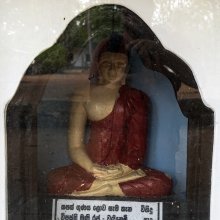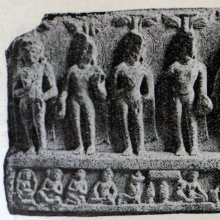Vipashyin, Vipaṣyin: 8 definitions
Introduction:
Vipashyin means something in Buddhism, Pali, Hinduism, Sanskrit. If you want to know the exact meaning, history, etymology or English translation of this term then check out the descriptions on this page. Add your comment or reference to a book if you want to contribute to this summary article.
The Sanskrit term Vipaṣyin can be transliterated into English as Vipasyin or Vipashyin, using the IAST transliteration scheme (?).
Images (photo gallery)
In Buddhism
Mahayana (major branch of Buddhism)
Source: Wisdom Library: Maha Prajnaparamita SastraVipaśyin (विपश्यिन्) or “views of all kinds” is the name of a Buddha according to the according to the 2nd century Mahāprajñāpāramitāśāstra (chapter VII).—“During the ninety-one kalpas from the Buddha P’i p’o che (Vipaṣyin) to the Buddha Kia chö (Kāśyapa), the Bodhisattva Śākyamuni accomplished the actions producing the thirty-two marks and, when he had accumulated (upacita) them, his six virtues (pāramitā) were perfected (paripūrṇa)”.
Vipaśyin was Buddha during the 91st kalpa, according to the 2nd century Mahāprajñāpāramitāśāstra (chapter XV).—Accordingly, “One thing that is difficult to find is a Buddha Bhagavat. It takes innumerable koṭi of kalpas to find one. In 91 kalpas, there have been only three Buddhas. [...] Before the good kalpa (bhadrakalpa), during the 91st kalpa, there was a Buddha called Vipaśyin, “views of all kinds”; [...]”.
According to the Mahāvadānasūtra, Buddha Vipaśyin had an “assistant” (upasthāyaka) named Aśoka.—Each Buddha had his assistant (upasthāyaka), a monk specially attached to his person, entrusted with fanning him, carrying his robe and bowl for alms-round, introducing visitors. The Sanskrit Mahāvadānasūtra has drawn up a list of the assistants who served the last seven Buddhas: [...] Aśoka for Vipaśyin [...]

Mahayana (महायान, mahāyāna) is a major branch of Buddhism focusing on the path of a Bodhisattva (spiritual aspirants/ enlightened beings). Extant literature is vast and primarely composed in the Sanskrit language. There are many sūtras of which some of the earliest are the various Prajñāpāramitā sūtras.
Tibetan Buddhism (Vajrayana or tantric Buddhism)
Source: Wisdom Library: Tibetan BuddhismVipaśyin (विपश्यिन्) is the name of a Tathāgata (Buddha) mentioned as attending the teachings in the 6th century Mañjuśrīmūlakalpa: one of the largest Kriyā Tantras devoted to Mañjuśrī (the Bodhisattva of wisdom) representing an encyclopedia of knowledge primarily concerned with ritualistic elements in Buddhism. The teachings in this text originate from Mañjuśrī and were taught to and by Buddha Śākyamuni in the presence of a large audience (including Vipaśyin).
Source: archive.org: The Indian Buddhist IconographyVipaśyin (विपश्यिन्) (or Vipaśyī) refers to one of the seven mortal Buddhas (mānuṣī) whose names appear last in the list of thirty-two Buddhas in Mahāyāna Buddhism.—The last seven Tathāgatas are well-known, and are designated by the Mahāyānist as Mānuṣī or “Mortal Buddhas”. When represented, the last seven Mortal Buddhas appear all alike; they are of one colour and one form, usually sitting cross-legged,with the right hand disposed in the Bhūmisparśa-mudrā (earth-touching attitute), which is the mudrā peculiar to Akṣobhya. [...] In paintings, the Mortal Buddhas [viz., Vipaśyin] have usually a yellow or golden complexion. [...] Sometimes they are represented as standing, in which case the appear under a distinguishing Bodhi Tree and with a distinguishing mudrā.
Vipaśyin is associated with the (Mortal) Buddhaśakti named Vipasyantī, and together they bring into existence the (Mortal) Bodhisattva named Mahāmati.

Tibetan Buddhism includes schools such as Nyingma, Kadampa, Kagyu and Gelug. Their primary canon of literature is divided in two broad categories: The Kangyur, which consists of Buddha’s words, and the Tengyur, which includes commentaries from various sources. Esotericism and tantra techniques (vajrayāna) are collected indepently.
Languages of India and abroad
Sanskrit dictionary
Source: Cologne Digital Sanskrit Dictionaries: Edgerton Buddhist Hybrid Sanskrit DictionaryVipaśyin (विपश्यिन्).—(compare prec. two; miswritten Vipaścin Divyāvadāna 141.16; (Ārya-)Mañjuśrīmūlakalpa 397.11; = Pali vipassi(n), both mgs.), (1) adj., having insight (into, in composition): sarvāvaraṇabuddha- samudra-°nā bodhisattvasamādhinā Gaṇḍavyūha 37.6; sarvāvara- ṇavigatena °nā kauśalyena 60.7; (2) name of a past Buddha, as in Pali the sixth before Śākyamuni, and so often as ‘first of seven Buddhas’, see s.v. tathāgata; otherwise named as a former Buddha: Mahāvastu i.2.5; 294.19; iii.240.6; 241.16; 243.14; 244.4; 245.18 ff.; 247.10; 249.1; Gaṇḍavyūha 206.12; stories of incidents which occurred during his Buddhahood, Mahāvastu ii.271.7 ff.; Divyāvadāna 141.16; 227.21 ff.; 282.19 ff.; Avadāna-śataka i.137.7 ff.; 349.3 ff.; ii.70.11; 96.3; 109.3; Kāraṇḍavvūha 14.12.
Source: Cologne Digital Sanskrit Dictionaries: Shabda-Sagara Sanskrit-English DictionaryVipaśyin (विपश्यिन्).—m. (-śyī) A Baudd'ha saint, the first of the seven principal Baudd'has. E. vipaśya and ini aff.
Source: Cologne Digital Sanskrit Dictionaries: Monier-Williams Sanskrit-English DictionaryVipaśyin (विपश्यिन्):—[=vi-paśyin] [from vi-paś] m. Name of a Buddha (sometimes mentioned as the first of the 7 Tathāgatas or principal Buddhas, the other six being Śikhin, Viśva-bhū, Kraku-cchanda, Kanaka-muni, Kāśyapa, and Śākya-siṃha), [Dharmasaṃgraha 6] (cf. [Monier-Williams’ Buddhism 136]).
Source: Cologne Digital Sanskrit Dictionaries: Yates Sanskrit-English DictionaryVipaśyin (विपश्यिन्):—[vi-paśyin] (śyī) 5. m. A Bauddha sage.
[Sanskrit to German]
Sanskrit, also spelled संस्कृतम् (saṃskṛtam), is an ancient language of India commonly seen as the grandmother of the Indo-European language family (even English!). Closely allied with Prakrit and Pali, Sanskrit is more exhaustive in both grammar and terms and has the most extensive collection of literature in the world, greatly surpassing its sister-languages Greek and Latin.
See also (Relevant definitions)
Ends with: Prithivipashyin.
Full-text (+12): Vipashcin, Bandhumant, Bandhumati, Sugandhamukha, Sakyamuni, Sikhin, Dharmayashas, Vakula, Bakula, Vakkula, Vipashcit, Ayuhpramana, Bandhuma, Kotivimsha, Anangana, Kshemakara, Krakasunda, Svastika, Ashoka, Sarvamitra.
Relevant text
Search found 12 books and stories containing Vipashyin, Vipaṣyin, Vipasyin, Vipaśyin, Vi-pashyin, Vi-paśyin, Vi-pasyin; (plurals include: Vipashyins, Vipaṣyins, Vipasyins, Vipaśyins, pashyins, paśyins, pasyins). You can also click to the full overview containing English textual excerpts. Below are direct links for the most relevant articles:
Maha Prajnaparamita Sastra (by Gelongma Karma Migme Chödrön)
2. Actions producing the thirty-two marks (dvātriṃśallakṣaṇa) < [Part 4 - The Bodhisattva in the Abhidharma system]
I. Apparent longevity of the buddhas < [Part 16 - Obtaining the immense longevity and immense radiance of the Buddhas]
The Avadāna of Sumana (or Sumanas, Karṇasumana) < [Part 1 - Obtaining easily an immense qualification]
Sutra of Ksitigarbha Bodhisattva's Fundamental Vows
The Mahavastu (great story) (by J. J. Jones)
Chapter XXIX - Anaṅgaṇa Jātaka < [Volume II]
Chapter XXI - Former Buddhas < [Volume III]
Chapter I - Prologue < [Volume I]
The Indian Buddhist Iconography (by Benoytosh Bhattachacharyya)
Ksitigarbha Bodhisattva fundamental vow sutra (by Johnny Yu)
Bodhisattvacharyavatara (by Andreas Kretschmar)
Text Section 44 < [Khenpo Chöga’s Oral Explanations]
Text Section 117 < [Khenpo Chöga’s Oral Explanations]
Related products

